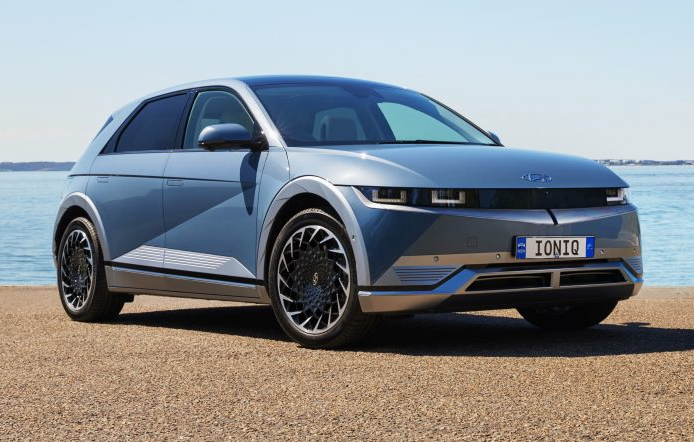The IONIQ 5 just might be the coolest looking vehicle I’ve ever driven. Forget ludicrously expensive sculptures of automotive jewellery with low swooping sensual body curves, exquisitely detailed air scoops with hand carved interior inlays of carbon fibre, titanium or rare timbers encased in the softest of quilted leather and Alcantara.
Nope, this sharp-edged defiantly angular box has all the hallmarks of an early eighties hot hatch back. And it’s just magnificent… because it wouldn’t look out of place parked on the side streets in Harrison Ford’s cult sci-fi movie, Blade Runner. Actually, it might have been what Racheal drove to the Tyrell corporation every day.
The IONIQ 5 is Hyundai’s first-ever fully dedicated battery electric model built on an all-new Electric-Global Modular Platform (E-GMP). From every angle, the outward design bares all the futuristic elements that you’d expect to see in a concept car.
Hyundai has thrown conventional thinking and the need to mimic others out the window, and let their design team have fun. Nothing was off limits—and I love the result!
The large clam shell bonnet sweeps down at the sides to meet the silver wheel arch mouldings that resemble the overlapping blades of a camera shutter. The front of the bonnet creates a sharp contrasting edge to accentuate the fiendish gloss black horizontal panel housed between the neoteric cubed and staggered LED daytime running lights. Below is a contrasting silver facia ledge that tapers back from the vehicle centre as it sweeps up and to the side of the pixel LED headlights, which illuminate at night and look amazing, giving the IONIQ 5 robotic-like facial features.
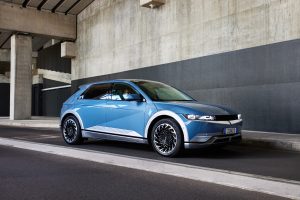
Sharp-edged creases abruptly cut short subtle body curves to create a unique optical illusion of two-tone paintwork as the light reflects differently over the change in surface profile. Silver highlight panels on the lower doors and front of the vehicle follow the same theme with recessed groves and sharp angles, further enhancing Hyundai’s innovative use of the parametric dynamic design of repeating mathematical patterns. The large silver active air induction ports at the front wouldn’t look out of place on a jet fighter and not only add to the cool factor, but they also provide temperature control for the battery pack.
The stylized 20” alloy wheels also have a futuristic appeal, with the polished outer spiral blades of a turbine winding around into an ever-diminishing centre to form the central black hub, wrapped in Michelin 255/45R20 Pilot Sport EV rubber. From behind, following the roof line is an aerodynamic rear spoiler featuring dual rectangular openings. And the same clean cubed motif design carries across the rear, illuminating at the edges for stop and turn signals with reverse lights and an LED light guide that runs the width of the vehicle.
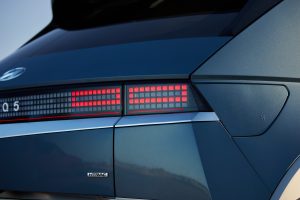
Take time to stare at the IONIQ 5 and no matter which angle or height you’re at, crouched or standing, the complex angles and subtle curvatures of this deceptively simple body shape not only provides slippery aerodynamics but is entrancing to look at.
Approach the vehicle and the remote fob allows the flush body door handles to pivot open for easy access to open the door. You can also use the button on the fob or press the small motif on the handle to open it. Cleverly, there’s a manual key built into the fob and you can easily access a standard door lock should the vehicle lose power or the battery in the fob goes flat.
Slide inside and the wow factor continues as the futuristic concept design of the exterior carries throughout the vehicle. The interior is an elegant and successful blending of modern technology and art déco elements of geometric and angular shapes, using glass, satin chrome and strong contrasting interior colours from soft greys, black highlights, and white leather.
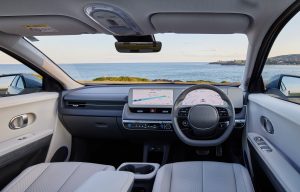
Front seating is very comfortable with both driver and passenger enjoying heating and cooling plus 12-way power adjustment, and 2-way lumber support with a cosy feature called relaxion mode… which puts either front seat into a zero-gravity position, so you can lie back and read a book, take a nap, or simply relax and listen to some music whilst you’re waiting for the public charger to top up your battery.
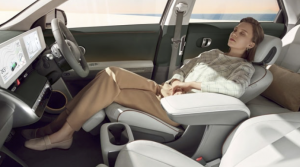
For me, the IONIQ 5 has broken the restrictive boundaries that impede conventional car interiors. It feels very open, uncluttered, and spacious, a sensation achieved by the totally flat floor and complete disconnect between the console and the dash. Clever design allows the console to be moved forward and back to position the arm rest for driver comfort, increase space in front or provide additional room for rear passengers. Set in the rear-most position, you can slide across the front seats from one side to the other. Handy if you get parked-in and must enter through the passenger’s door. Which you’d only need if you forgot how to use the key fob to move the vehicle forward autonomously from its squeezy predicament. How George Jetson is that!
There are two large clear horizontal 12.3inch displays, with two background colour options, the first being all white, very Apple-esque… or black giving a more traditional look. The first screen is mounted directly in front of the driver, meaning you don’t have to look across to a centre display and remove your eyes from the road ahead. It shows dedicated vehicle information—speed, battery charge, regenerative braking level, digital instrumentation for trip computer, turn by turn navigation, power consumption, and charge input.
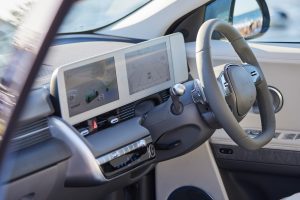
There are also three themes corresponding to the driving modes of Eco, Normal and Sport. The latter is in red, presumably because everyone knows red is faster. If you hold the mode button for a few seconds, you can induce snow mode, which works with the IONIQ’s AWD system to distribute torque front and rear for improved traction and control on slippery surfaces via Hyundai’s traction system HTRAC.
The second display is a capacitive touch screen where you can access a host of vehicle functions such as GPS, EV data, settings, phone media, HVAC controls, seat temperature control and others. There’s standard wired connectivity for Apple and Android, but disappointingly no wireless option. The screen is responsive and intuitive to use. The only challenge for me was I needed to lean over to reach the far side of the screen as it’s rather wide.
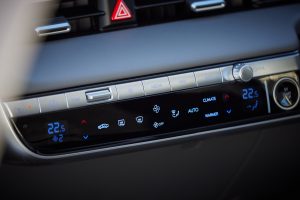
I really like the array of physical buttons below the second screen, allowing quick access to map, nav, media, cameras, and parking sensors with a toggle for radio channels and a rotary volume control. There’s also a black facia below that illuminates when the vehicle is powered on, providing a touch control for climate settings, fan speed and temperature. What was odd, and a little annoying, was you had to press the warmer setting on the lower panel to enter the heated and cooled seat function on the main screen—why not just have toggle switches for warmth or cooling of the seats?
The heated steering wheel has manual tilt and reach, with plenty of scope to get the positioning just right. It’s an interesting two spoke design because, unlike every other vehicle I’ve driven, there’s no brand logo or model reference on other than four little squares. Illuminated icons provide access for audio, phone, and voice control on one side of the steering wheel with lane safety, smart cruise and speed limiter on the other.
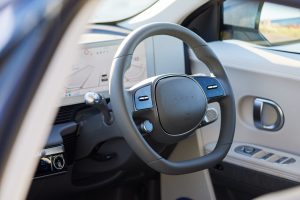
Spotting paddle shifters in an EV with only one gear made me think that things just got weird. Until I realised that they cleverly control the strength of application of the regenerative braking system and can enable Hyundai’s iPedal to control acceleration and deceleration by just one pedal. Having mastered that technology in another EV, I think it’s one of the best unique features of EVs.
Gear selection is via a twist control stalk mounted low on the steering column. Simply rotate forward for drive, back for reverse, and a middle position for neutral. What seems odd to begin with becomes second nature as you develop muscle memory. Park is engaged by pressing the button on top of the stalk.
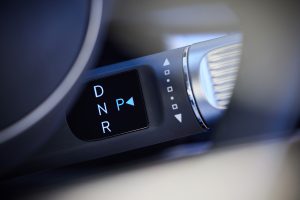
The heads-up display is clear and has good position adjustment. The augmented reality option shows dynamic directions in your field of vison with moving images showing when to turn, something you’d normally expect to find in more expensive vehicles.
For the audiophiles amongst us, choose from AM, FM and DAB radio or Bluetooth streaming and pump it through a Bose premium audio system using 8 speakers and an external amp. Interior ambiance can be altered with adjustable LED Ambient Mood Lighting throughout the cabin. The speaker surrounds have a satin alloy appearance during the day, but glow at night along with the door armrests. Plus, you have the convenience of wireless charging with four USB ports, 2 front and rear and 2 standard 12v sockets, one at the very front and the other in the cargo area.
Storage is courtesy of a small cubby on the front floor, low and upper storage in the console with dual coffee cup holders, and the obligatory door pockets. I liked the way the glove compartment slides open like an office drawer allowing you to access all the contents with ease.
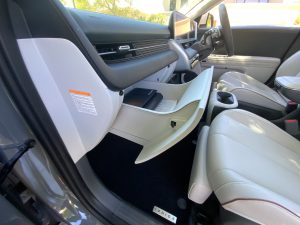 Rear accommodation is very good; there’s plenty of leg room, thanks to an impressive 3m wheelbase. Seating is supportive and comfortable with electric slide forward and aft if you need more room or extra space in the rear. Clever positioning of the rear passenger’s air vents on the B pillar meant getting cool air above your kneecaps, as is the case with rear console vents. Another quirky design feature which caught my attention was the way the head lining parted from the middle like the roof doors on a rocket silo to expose the panoramic glass roof.
Rear accommodation is very good; there’s plenty of leg room, thanks to an impressive 3m wheelbase. Seating is supportive and comfortable with electric slide forward and aft if you need more room or extra space in the rear. Clever positioning of the rear passenger’s air vents on the B pillar meant getting cool air above your kneecaps, as is the case with rear console vents. Another quirky design feature which caught my attention was the way the head lining parted from the middle like the roof doors on a rocket silo to expose the panoramic glass roof.
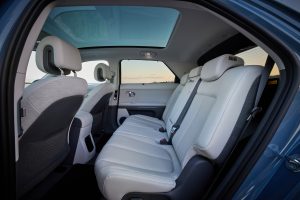
Pop the electric rear hatch and you’ve 527L of storage behind the second row; drop them down and that jumps to a respectable 1,587L. Just keep in mind that the slant of the rear door can impede taller items. meaning your Aussie Shepherd may have to lie down.
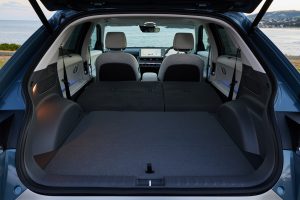
The rear cargo area comes with a dual-position retractable cargo cover, a luggage net and four tie-down hooks. If you wonder why EVs without an engine offer little space under the bonnet beyond storage for charging cables, then note that manufacturers frequently move many internal components that consume interior space into the engine bay to provide a more spacious interior and slimline dash.
When it comes to being environmentally friendly, Hyundai gave their sustainability team free rein with the realisation that green isn’t just about the power plant. The attractive marble looking door inlays are 100% recyclable paperette. Floor coverings are woven from fibres made from recycled plastic bottles and the soft materials throughout the cabin are formed from sustainable fibres like sugar cane, wool and poly yarns. Even the interior painted surfaces are coated with BIO paint derived from rapeseed flowers and corn.
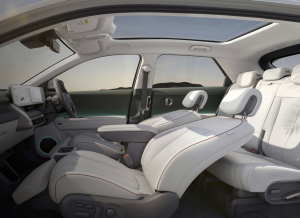
Not only is it greener on this side of the fence; the visual appeal, tactile touch and quality finish is very impressive. Full marks for smart eco-friendly design done well.
Let’s look at the power pack. Our AWD IONIQ 5 test vehicle utilised a 72.6kWH liquid-cooled lithium-ion battery powering two permanent magnet synchronous motors. Producing 155kW and 350Nm at the rear and 70kW and 255Nms at the front. With an available 225kW and 605Nm on tap in sports mode, the IONIQ 5 will propel itself from 0-100kph in a conservative 5.2s.
The AWD dual motor had an indicated range of WLTP of 430km, equating to 19 kWh/100. But that will vary on driving style, operation of vehicle accessories, HVAC, weather conditions and if you’re towing a trailer.
Yes, the IONIQ can pull a load of 750kg unbraked up to 1,600kg braked—as long as you don’t exceed the 100kg tow ball weight. But it will easily cover a box trailer run to the tip or a small lightweight camper.
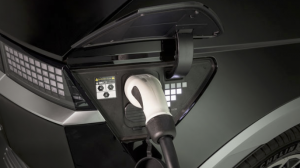
The charging port is located under a neat little power operated flap on the driver’s side at the rear of the vehicle, with both Type 2 AC and IEC FF DC charging ports. Should the power door fail, you can manually open it from inside the rear compartment via a small pull tab. The IONIQ 5 can also provide voice notification of the battery charging status via its external speaker system. Charging via a standard 240V household GPO will be a slow process. To reach a 100% charge at the maximum rate of 10Amps, would take 31 hours.
Utilising the onboard AC charger to accept an input of 10.5kW, you should reach an 80% charge in just over 6 hours.
Leveraging the onboard DC fast charger at a 50kW input, up to 80% charge can be achieved in a little over an hour, about the same time to enjoy a leisurely lunch on a road trip.
With the AWD IONIQ having an 800V architecture, ultra-fast charge can be achieved with a 350kW input reaching an 80% charge in under 20 minutes. Now that’s seriously quick—as long as you have access to an appropriate charging station, of course.
Utilising the V2L function, you can even use the vehicle as a large mobile charging station to charge other devices or power electrical equipment. Connecting the supplied adapter, you have access to a 250V, 3.6kW supply at 15A. But here’s the best part… the IONIQ 5 can provide Vehicle-To-Vehicle charging functionality via the portable emergency charging cable. That’s thinking of an EV dominant future!
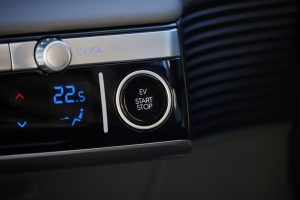
Push the IONIQ 5’s stop/start button on the dash, twist the gear lever to engage drive and you’re good to go. You’ll reach the legal speed limit with gratifying urgency as you enjoy the lusty responsive torque of the electric motors. The first impression is that the IONIQ 5 is quick, quiet and smooth; it doesn’t seem to drive as much as it glides to its next destination.
Hyundai have paid careful attention to weight reduction through the use of lightweight aluminium alloy in the construction of the clamshell bonnet, high voltage battery housing, electric motors, steering and suspension components. Adding further efficiency is the implementation of hot stamped high-tensile strength steel, which is lighter and twice as rigid as conventional mild steel. Hyundai has achieved a lightweight structure with remarkable chassis rigidity, offering solid protection for occupants and the battery.
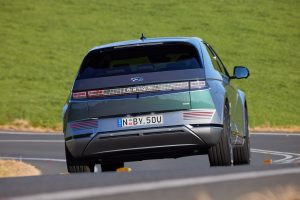
Approaching a sharp corner, leaning heavily on the pedal in manual braking mode, the IONIQ 5 washes off momentum with reassuring confidence thanks to the 345mm ventilated discs at each wheel powered by an Integrated Electric Booster (IEB). The system can generate a rapid hydraulic response, enabling ultra-fast control of automatic emergency braking functions. The internal pedal simulator provides a realistic pedal feel for driver application.
Suspension is standard MacPherson strut front, and multi-link rear end coupled to high-performance dampers. The resulting ride comfort is very good, soaking up all but the biggest of bumps with minimal intrusion into the cabin. Despite a somewhat more insular feel with less driver feedback on changing road surfaces, the steering response is direct and nicely weighted to provide an enjoyable experience on gentle winding roads. Cornering is flat thanks to the exceptionally low centre of gravity and close to ideal weight distribution achieved by mounting the battery along the floor pan and both electric motors deep in the chassis.
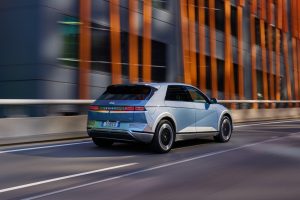
So pleasant was the driving experience that I made excuses to go for another drive. This is a vehicle that likes to cruise rather than being hustled unnecessary.
As for safety features, if you can think of it, the IONIQ 5 probably has it covered. It achieved a full 5-star rating from ANCAP for good reason. Feel free to make yourself a large coffee and grab a packet of bikkies… visit the Hyundai website and download the spec sheet—its mind blowing!
While the exterior may exude a futuristic sporty appeal and the straight-line figures provide hot hatch credibility, the IONIQ 5 is actually relaxed, calming and soothing. It’s lovely to drive, cocooning you in a quiet peaceful environment to be the near-perfect stress lowering commuter for suburban and city traffic.
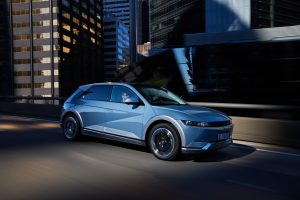
The longer you spend in the IONIQ 5, the more you will appreciate what Hyundai has achieved through the seamless convergence of practical functionality and modern technology, encapsulated in a simple and elegant design that really works.
With the astonishing quick charging capability of the AWD 800V platform, this is one EV that I’d be happy to use for longer trips based on available charging stations.
I think it’s fair to say that the Hyundai design team didn’t just think outside the box; they left it on the boardroom table, turned the lights off and closed the door behind them!
Fast Facts:
Model: IONIQ 5 Dual Motor AWD.
Base Price: $75,900 plus on-road costs.
Engine: Twin Permanent Magnet Synchronous Motor
Output: Combined 225W/605Nm
Battery Capacity 72.6kWh
Energy Consumption: 19.0 kWh / 100km
Suggested Range: Up to 430 km (WLTP)
Safety Rating ANCAP 5 Stars.















